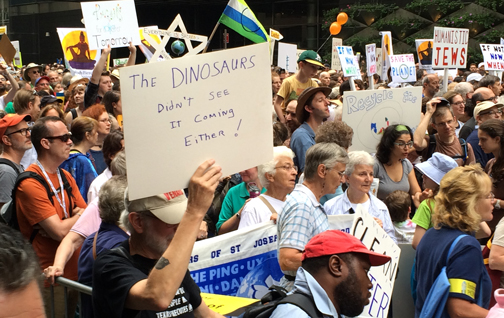In 2015, there has been barely any discussion of climate change in the run up to the election campaign. It seems unlikely that it will be introduced as a major topic by political leaders before election day.
But UKCIP would like to offer voters, and candidates, some climate adaptation questions and issues to drop into doorstep discussions, schoolgate debates and office kitchen catch-ups.
So, why is adaptation to climate change relevant?
Preparing for the impacts of climate change is known as adaptation. Climate change most clearly manifests itself in the danger and misery caused by extreme weather (storms, heatwaves, droughts), as well as the slower shifts we are experiencing, for example in the length of seasons and sea level rise. These impacts of climate change all contribute to increasing pressure on infrastructure, business and the health and well-being of citizens.
Adaptation solutions to protect against climate impacts vary in scale and complexity, for example, engineering solutions to prevent flooding, making better use of green and blue infrastructure in urban areas, or raising awareness of how to keep cool in a heatwave. We are already making some adaptation changes, because climate change is happening and will continue to occur for several decades at the very least. For example, many flood defences already consider account of sea level rise. But stopping the causes of climate change – mainly by switching away from using fossil fuels (coal, oil, gas) – will, in the long term, be the best way to avoid the most severe impacts of climate change.
The climate is changing
There is little doubt that the climate is changing. In the UK, 2014 was the warmest year on record and the fourth wettest, while eight of the top ten warmest years have occurred since 2002. There are plenty of reliable online resources that provide technical information to confirm that climate change is real and caused for the most part by our use of fossil fuels. And warming global temperatures don’t mean it will just be less cold everywhere, it will change weather patterns for everyone, and in some areas the changes will be much more severe than others.
Preparing for the climate changes we can’t avoid is a sensible way to protect our society and to ensure that our children and their offspring will have the chance to enjoy a good quality of life.
There is already plenty of adaptation underway in the UK
The government produces a Climate Change Risk Assessment every 5 years, and this helps to create the National Adaptation Programme.
Many large companies that provide services we rely on such as energy and water supply have produced reports to show how they are preparing for changes in our climate.
Other sectors and businesses have also developed adaptation plans and resources. The NHS in England has adaptation to climate change as one of its strategic goals. The tourism industry has online guidance and information for tourism businesses. An annual heatwave plan is produced by the Department of Health, with advice for householders and carers on how to keep cool and identify the symptoms of heat stress.
But we need to do more…
Here are some ideas to discuss with party political representatives on the doorstep, or to introduce in your own discussions with friends, family and colleagues – even when it isn’t election time!
Weather and climate affect all of society in one way or another – it therefore makes sense to support adaptation at a cross-department level rather than treating it as a single, discrete issue. A committee of MPs recently recommended that the government should have an adaptation champion.
Although the UK has made a good start on adaptation, more needs to be done to encourage businesses and organisations to consider climate impacts as a matter of course in their business plans.
Local councils have unique access to, and are able to influence, organisations, businesses and the public in a number of ways. The coalition abolished the main incentive for local government to take action on adaptation (National Indicator 188). So, while many local councils made a strong start on adaptation, it is now harder for adaptation to be prioritised alongside the other work of local government. With greater support, councils could help more businesses and communities to take the first steps to adapting to climate impacts.
We have access to plenty of evidence and examples that can help us to begin the process of adaptation, and it is also important to avoid doing some things that will make adaptation difficult – such as building homes on land at risk of flooding.


